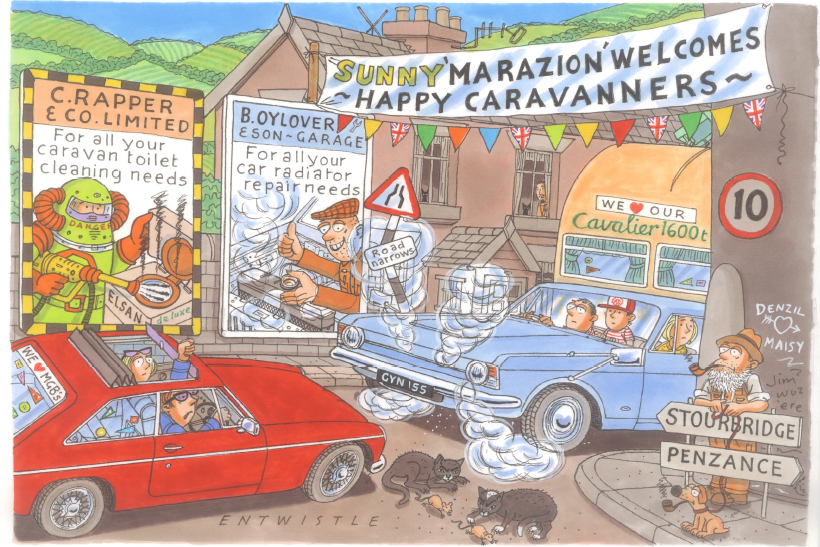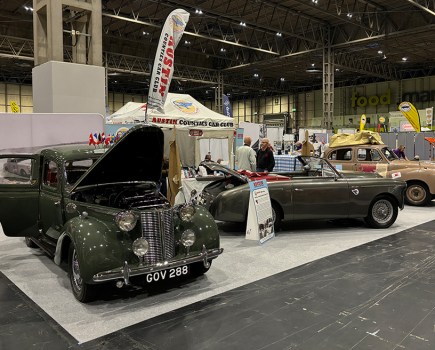Paul Guinness looks back at a childhood of touring caravan holidays, traffic jams and tow cars…
The month of August and the summer holidays have just passed. And for countless families around the UK, that meant it was time to jet off on holiday, enjoying the fortnight in the sun that they’ve been saving all year for. It’s the way of things for so many folk in 2017, but it wasn’t always so. Back in the ’70s, despite the arrival of the package holiday and the new-found option of swapping Skegness for Spain, the vast majority of us seemed to holiday here in the UK.
At least, that’s how it seemed when I was growing up. I started the ’70s as an excitable five-year-old and ended the decade in my typically grumpy mid-teens, and throughout it all most of my friends’ parents seemed to opt for the stay-in-Britain type of holiday. Some went camping, others chose the traditional seaside B&B; I can just about recall the Llandudno guest house that I was taken to at the beginning of the decade, and I still have the bright red MGB GT Corgi model that I was treated to whilst we were there.
By early 1971, however, things were changing. My parents decided that the future was suddenly caravan-shaped and, after poring over innumerable brochures of all the latest four- and five-berth models, my father finally invested some of his hard earned salary in a new 16-foot-long Cavalier 1600t.
No longer would we be sleeping in other people’s beds in less-than-perfect guest houses. We had our own shiny new caravan, complete with tables that folded to make two double beds (one each end), a surprisingly well-equipped kitchen area, a wardrobe or two, copious quantities of overhead storage cupboards and, of course, the obligatory (and, with the benefit of hindsight, rather cramped) toilet room where the latest in Elsan technology could be found.
Actually, when I say Elsan technology, I really mean an Elsan toilet that didn’t even flush. You lifted the toilet lid only to see a large quantity of blue liquid and the remains of what the rest of the family had already deposited. Quite frankly, it was revolting. Happily, however, that particular Elsan was swapped for a more modern caravan toilet (complete with push-button flush) some years later. Civilisation (or something vaguely resembling it) eventually arrived.
And so our years of caravanning began. Each Whitsun we would go to Wales for the week, invariably heading for the same clifftop caravan site at Mwnt, near Cardigan; and for the last two weeks in August we’d be off to West Cornwall, staying at another favourite site at Boleigh, near Lamorna Cove. Both caravan sites were located on working dairy farms, which somehow adds a touch of excitement when your age is a single-digit figure.
LONG JOURNEYS
These were both great locations, and a good time was had by all. It’s just a shame that we had to endure seemingly never-ending (or so they felt at the time) journeys, which throughout the ’70s involved a variety of different company cars of my late father’s. Disparate models such as a Rover 2000TC, Zephyr MkIV and Princess 1800 all managed to tow that Cavalier 1600t over the years, each one doing a splendid job from what I can recall. But the amount of time each journey involved was no laughing matter.
We lived in Stourbridge (which, at the time, was still in the county of Worcestershire, prior to the ‘creation’ of the West Midlands), and so our trip to Mwnt meant driving through Shrewsbury, on towards Aberystwyth and then down to Cardigan Bay – a winding journey of almost 150 miles. The when August came around, the 275-mile trip to Cornwall proved even more torturous, not helped by the fact that in its early days the M5 stretched scarcely much further than Bristol, which again resulted in A- and B-road tedium as we joined the tens of thousands of other holidaymakers heading south-west for what we in the Midlands colloquially referred to as the Industrial Fortnight.
A trip from the Midlands to Cornwall these days is a relative joy, with the A30 bypassing the vast majority of towns that proved to be such bottlenecks in the ’70s. Anyone old enough to recall being stuck in places like Indian Queens (traffic at a standstill, temperature gauge rising, tempers flaring) will, I’m sure, empathise. I’ll certainly never forget the one occasion when my father tried to manoeuvre that large Cavalier home-on-wheels through the narrow main street of Marazion, this now-bypassed town being completely unsuited to the streams of caravans that effectively blocked it as they endeavoured to head towards Penzance.
So time-consuming was the trip to Cornwall in those days, my parents decided the best idea was to set off one day, stop overnight in the caravan (usually in a noisy layby) and then continue again the next morning. For a journey that could take up to seven hours or more in the summer months, it was a sensible decision; but it did little to calm the tense atmosphere, with arguments ensuing as the temperature both outside the car and inside its cooling system escalated in the August sunshine.
If, like me, you went on caravan holidays as a child, there’s every chance you’ve since gone on to have a caravan of your own, revelling in the freedom that it provides; but I’m afraid it’s not for me. Don’t get me wrong, I had some great times and grew to love both the Welsh and the Cornish sites on which we stayed; but there’s something that’s made me shy away from caravanning ever since.
Maybe it’s the memories of the curtains sticking to the windows each morning thanks to crazy levels of condensation; or perhaps it’s the lack of on-board space now that I’m a six-foot 52-year-old with claustrophobic tendencies. I do wonder, however, whether it’s the revulsion felt towards that original Elsan toilet that has me looking online for hotels these days rather than scouring eBay for a secondhand caravan. I’m sure caravanning has changed for the better in the 21st century… but forgive me if I don’t join in the fun.








